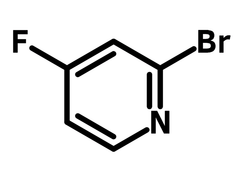2-Bromo-4-fluoropyridine
CAS Number 357927-50-5
Chemistry Building Blocks, Fluorinated Building Blocks, Heterocyclic Building Blocks, Materials, MonomersA halogenated pyridine building block
As an intermediate for ligands and catalysts synthesis
Specifications | MSDS | Literature and Reviews
2-Bromo-4-fluoropyridine (CAS number 357927-50-5) is a dihalogenated pyridine with a bromine and a fluorine at 2- and 4-positions. 2,2'-Bipyridine ligands can be easily synthesized from 2-bromo-4-fluoropyridine reacting with bis(tributyltin) through Stille coupling. The fluoro substituents originated from 2-bromo-4-fluoropyridine enable the as synthesized 2,2'-bipyridine ligands for further functionalization. A Janus-type organoiridium complex is prepared with such method, bearing both hole- and electron-transporting moieties. 2-Bromo-4-fluoropyridine is also used to synthesize a bis(pyridine) ligands with 1,2-ethynylbenzene via Sonogashira coupling. The bis(pyridine) stabilizes iodine cation through [N−I−N]+ halogen bonding, for developing halogenating reagents.
A chemical catalyst is designed based on 2-bromo-4-fluoropyridine for site-selective lysine acylation of histones.
Multiple functional groups
For facile synthesis
Fluorinated benzonitrile building block
For drug discovery, organic synthesis and medicinal chemistry
Worldwide shipping
Quick and reliable shipping
High purity
>98% High purity
General Information
| CAS Number | 357927-50-5 |
| Chemical Formula | C5H3BrFN |
| Full Name | 2-Bromo-4-fluoropyridine |
| Molecular Weight | 175.99 g/mol |
| Synonyms | 4-Fluoro-2-bromopyridine |
| Classification / Family | Fluorinated building block, Heterocyclic building block, Ligands, Dyes, Catalysts |
Chemical Structure

Product Details
| Purity | 98% |
| Boiling Point | Tb = 188 ± 20 °C (predicted) |
| Relative Density | 1.69 g/mL at 25 °C |
| Appearance | Colourless liquid |
MSDS Documentation
 2-Bromo-4-fluoropyridine MSDS Sheet
2-Bromo-4-fluoropyridine MSDS Sheet
Literature and Reviews
-
Highly phosphorescent cyclometalated iridium(III) complexes for optoelectronic applications: fine tuning of the emission wavelength through ancillary ligands, Ł. Skórka et al., J. Phys. Chem. C, 120(13), 7284–7294(2016); DOI: 10.1021/acs.jpcc.6b01663.
-
Janus-type dendritic organoiridium(III) complex bearing hole- and electron-transporting moieties: synthesis, luminescence properties, and OLED applications, N. Okamura et al., Bull. Chem. Soc. Jpn., 91, 1419–1428(2018), DOI: 10.1246/bcsj.20180139.
-
Kinetic analyses and structure-activity relationship studies of synthetic lysine acetylation catalysts, K. Yamatsugu et al., Bioorganic Med. Chem. Lett., 26(19), 5359–5367(2018); DOI: 10.1016/j.bmc.2018.07.009.
